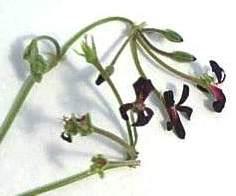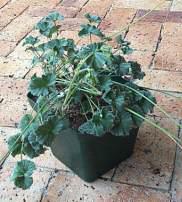Pelargonium sidoides
Pelargonium sidoides DC.
Family: Geraniaceae
Common names: black pelargonium (Eng.) kalwerbossie, rabassam (Afr.), ikubalo, iyeza lesikhali (Xhosa), khoara-e-nyenyane (Southern Sotho), umckaloabo (German remedy)
Introduction
A tufted pelargonium with velvety silver leaves and almost black flowers that is a well known medicinal plant in South Africa.

Description
Description
Pelargonium sidoides forms a rosette-like plant with crowded leaves. It is very similar to some forms of P. reniforme, but is easily distinguished by its blackish, rather than pink petals. The long-stalked leaves are mildly aromatic, heart-shaped and velvety. The distinctive dark, reddish-purple (almost black) flowers are present almost throughout the year, but occur mostly from late spring to summer (October - January) with a peak in midsummer (December).

The plant is an evergreen in cultivation, but it probably dies back in nature during droughts and in winter (May to August). The system of thickened underground root-like branches is a special adaptation which enables the plant to survive grass fires which occur almost annually over much of its range.
Conservation Status
Status
According to the Red LIst of South African Plants, Pelargonium sidoides is assessed as Least Concern (LC).
Distribution and habitat
Distribution description
Pelargonium sidoides has a wide distribution. It occurs throughout the eastern Cape, Lesotho, Free State and southern and south-western Gauteng in the Republic of South Africa. It usually grows in short grassland and sometimes with occasional shrubs and trees on stony soil varying from sand to clay-loam, shale or basalt. P. sidoides is found at altitudes ranging from near sea level to 2300 m in Lesotho. It is found in areas which receive rainfall in summer (November to March) varying from 200 - 800 mm per annum.

Derivation of name and historical aspects
History
The genus name Pelargonium is derived from the Greek word Pelargos which means stork. This refers to the rostrum of the schizocarp (seed capsule) which resembles the bill of a stork. The species name sidoides reflects the resemblance of the foliage to that of a European plant, Sida rhombifolia.
The family Geraniaceae consists of five genera; Geranium, Erodium, Monsonia, Sarcocaulon and Pelargonium. The genus Pelargonium consists of more than 200 natural species. The larger majority occurs in South Africa, while a few species occur in tropical Africa, Syria, Australia and on a few islands in the Indian Ocean. About 80% of the South African species are confined to the winter rainfall south-western Cape.
Ecology
Ecology
In its natural habitat this plant is able to withstand the winter dry, cold season by going dormant and shoorting again from the roots when the rains come.
Uses
Use
This species has well recorded medicinal properties and is being used by the pharmaceutical industry, in this case for the treatment of bronchitis. It is utilized for a variety of folk-medicinal purposes, including the treatment of sore throats and congestion, resulting in the colloguial name 'Rabassam'.
Growing Pelargonium sidoides
Grow
Pelargonium sidoides can be planted in rockeries in full sun. It is also an excellent pot plant.
Pelargonium sidoides experiences moderate, rather than high, summer temperatures and winter frost or even snow over much of its range. This plant needs less water during winter and watering should be increased at the beginning of summer (November to March). Top dressing with a slow release fertilizer in spring will improve growth and flowering in summer. In winter, dead leaves and old flower stalks should be removed from the plant.
This plant is easily propagated from seed or by means of basal cuttings in autumn (March to May). The cuttings should be prepared and the base dipped in a rooting hormone and then be placed in containers with coarse riversand which has been pre-watered with a fungicide. The containers with cuttings should then be placed in cold-frames to root. If plants are kept in glasshouses, yellow sticky traps should be placed strategically to combat white-fly.
References
- Van der Walt J.J.A. & Vorster P.J. Pelargoniums of Southern Africa. Volumes 1 and 3.
Credits
Ebrahim Lawrence
Kirstenbosch National Botanical Garden
May 2001
Plant Attributes:
Plant Type: Perennial
SA Distribution: Eastern Cape, Free State, KwaZulu-Natal, Mpumalanga, North West
Soil type: Sandy, Clay, Loam
Flowering season: Spring, Early Summer, Late Summer, Autumn
PH: Acid, Neutral
Flower colour: Brown, Purple
Aspect: Full Sun
Gardening skill: Easy
Special Features:
Horticultural zones











Rate this article
Article well written and informative
Rate this plant
Is this an interesting plant?
Login to add your Comment
Back to topNot registered yet? Click here to register.